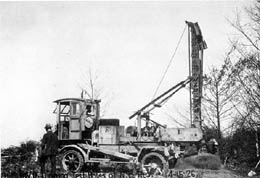In 1929, the Tacoma Water Department drills the first of its "A" Series wells. Well 1-A near South 63rd Street and Clement Avenue produces 4.4 million gallons of drinking water a day. A total of 12 wells will be dug in South Tacoma over the next 20 years.
During the 1920s, Tacoma got its water from the Green River and from some wells drilled in the 1900s. The tideflats area could not be exploited for its industrial potential until the city provided more water. Pulp mills in particular needed water. One part of the master plan of Public Utilities Commissioner Ira S. Davisson and Water Superintendent Willibald A. Kunigk to get more water was use Lake Kapowsin, which promised four times the water of the Green River. But landowners around the lake battled condemnation in the courts until the stock market crash of 1929 put that part of the master plan on hold.
The Water Department discovered fresh water below ground at a depth of 260 feet. Wells were much cheaper than pipelines and the first five "A" Series wells produced almost 24 million gallons of water, more than half the Green River system's output. A second series of three wells was added in June 1940. Three more wells in 1948 pushed the total output to 62 million gallons a day.

